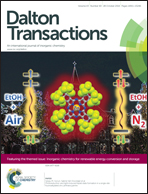Synthesis of novel palladium(ii) complexes with oxalic acid diamide derivatives and their interaction with nucleosides and proteins. Structural, solution, and computational study†
Abstract
Novel palladium complexes, KH[Pd(obap)]2·3H2O (3) with oxamido-N-aminopropyl-N′-benzoic acid and [Pd(apox)] (4) with N,N′-bis(3-aminopropyl)ethanediamide, were synthesized. Exhaustive synthetic, solution and structural studies of the two Pd(II) complexes are reported. The binary and ternary systems of the Pd(II) ion with H2apox or H3obap as primary ligands and nucleosides (Ado or Cyt) as secondary ligands, are investigated in order to better understand their equilibrium chemistry. The relative stabilities of the ternary complexes are determined and compared with those of the corresponding binary complexes in terms of their Δlog K values. The species distribution of all complexes in solution is evaluated. Fluorescence spectroscopy data shows that the fluorescence quenching of HSA is a result of the formation of the [PdL]-HSA complex. The structure of complex 3 is confirmed using X-ray crystallography. The results are compared to those obtained for palladium complexes of similar structures. Density functional theory (DFT) has been applied for modelling and energetic analysis purposes. The nature of the Pd–N(O) bond interaction is analyzed using NBO. We report here docking simulation experiments in order to predict the most probable mechanism of pro-drug-action. The next free binding energy order of the best scores from the [PdL]-DNA docking simulations, cis-[Pt(NH3)2(H2O)2]2+ > [Pd(obap)] > [Pd(mda)], has been observed in the case of DNA alteration. For the ER and cytosolic stress mechanisms the results of the docking simulations to the chaperons Grp78 and Hsc70 are promising for possible applications as potent protein inhibitors (Ki of [Pd(mda)]/GRP78 being ∼66 μM and Ki for [Pd(obap)]/HSC70 being 14.39 μM).


 Please wait while we load your content...
Please wait while we load your content...